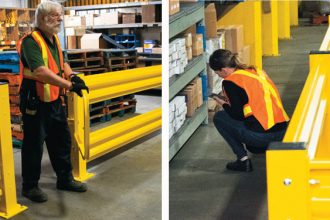Safeguard Employees And Facility Structures In The Dock Area With These 7 Styles Of Protective Guarding

With everything that goes on in (and through) a facility’s shipping and receiving docks, it’s no wonder that space is frequently the most heavily trafficked in a building. From a variety of over-the-road vehicles backing in and pulling away and forklifts ferrying pallet loads into and out of trailers, to personnel manually loading and unloading cases with or without pallet jacks and drivers entering and exiting the area to complete paperwork — there’s a lot of action in what can often be a crowded space. While that flurry of activity can be highly productive, it can also pose a high potential for injuries. To mitigate those risks there are a variety of specialized protective guarding solutions available for different areas within the dock area to safeguard employees and facility structures from harm. They include:
- Wire Mesh Safety Cages. Made of steel wire mesh panels, these cages are placed immediately inside of a building’s entrance (typically adjacent to the dock doors) to allow non-employees access into the facility. Truck drivers who are not employees of the operation, for example, will likely be entering the dock area with paperwork. Restricting their access into the building ensures they cannot walk around the dock area or elsewhere in the facility unaccompanied, reducing the risk of them being struck by a forklift or other vehicle. Safety cages also increase the overall safety and security of the operation, including protecting employees from possible assailants, and products and other assets from damage or theft.
- Dock Door Barriers for Personnel. As most dock door openings are elevated to align the floor of the facility with the floor of the parked trailer, there is a risk that personnel on foot might fall through the open edge if the door remains open after the trailer departs. To protect these ledges when a dock door is in the open position, there are four types of secondary barriers and gates available: accordion style with crossbars that expand as the guarding is pulled across the opening and contract when it is pushed back for access; a hinged barrier that folds up from the middle into an A-frame shape for storage; netting that extends across the opening; and a pivoting guard gate that drops down 90-degrees to obstruct the opening, similar to a railroad crossing guard. The safest solution is to install a gate that closes automatically as the truck drives away so that closing the gate is not dependent on the actions of an employee.
- Heavy-Duty Dock Door Barriers for Vehicles. To prevent operators of forklifts from driving off elevated dock ledges when the door is open, and no trailer is present, heavy-duty engineered dock door gates and barriers are available. Because of the significant weight of these vehicles and the potential force they may transfer in an impact, it is important to ensure that the barrier is engineered specifically to stop the vehicle before it drives over the open ledge. Should the dock door be closed, having such a barrier in place can protect it from damage caused by a forklift or pallet impact.
- Dock Door Protection. Used to prevent vehicle contact with vulnerable facility structures — particularly dock door openings, tracks, and the doors themselves — safety height restrictors and bollards are engineered to provide physical protection against impacts. They also serve as a visible reminder to forklift operators about height limits and vulnerable components as they approach an opening with their load.
- Dock Bumpers. To prevent facility damage when a tractor trailer backs into a dock door opening, a variety of cushioning bumpers can be installed. These bumpers are applied to the outside of the building and are engineered to sustain the force of an impact as the trailer approaches at a specific speed. This protects the opening as well as exterior walls from damage due to driver error or miscommunication.
- Dock Lift Gates and Guardrails. Whether pit-mounted or surface-mounted, dock lifts that typically make the transition from ground level to the tractor trailer or dock level often have siderails but typically lack permanent protective barriers at the loading and unloading end of the device. Those open ends can become a fall hazard, particularly as the lift rises to its elevated height or sinks back down. To reduce the risk of a worker falling off an open end, gates can be attached to each end that close either manually or automatically when the lift is in motion, and open when it The safest solution is to install a barrier that closes automatically as the lift elevates.
- Temporary Flatbed Trailer Safety Barriers. Because they lack fixed, permanent protective barriers on their sides, flatbed trailers pose a high risk to forklifts driving on them to load or unload products. Their limited navigability increases the chance that the forklift might roll off the open edge. To reduce this risk, temporary flatbed trailer safety barriers can be placed in the rail pockets or slots on the trailer’s sides. These can be either panels up to 4-feet tall, or short curbs that stop the wheels without impeding the load. The barriers are removed after loading.
While many of these protective devices for dock applications can be purchased online, those products may or may not be the optimal solution for a given situation. In many cases, the guarding system must meet certain design criteria in order to properly function as intended. These include proper sizing to match a given area, the ability to resist variable degrees of impact force, ease of use, and more.
Before purchasing a solution that might work, consult with the members of the Protective Guarding Manufacturers Association (ProGMA) for additional insights about how to select the right solution from the different options to ensure it will reduce the risk of injuries in your operation.



